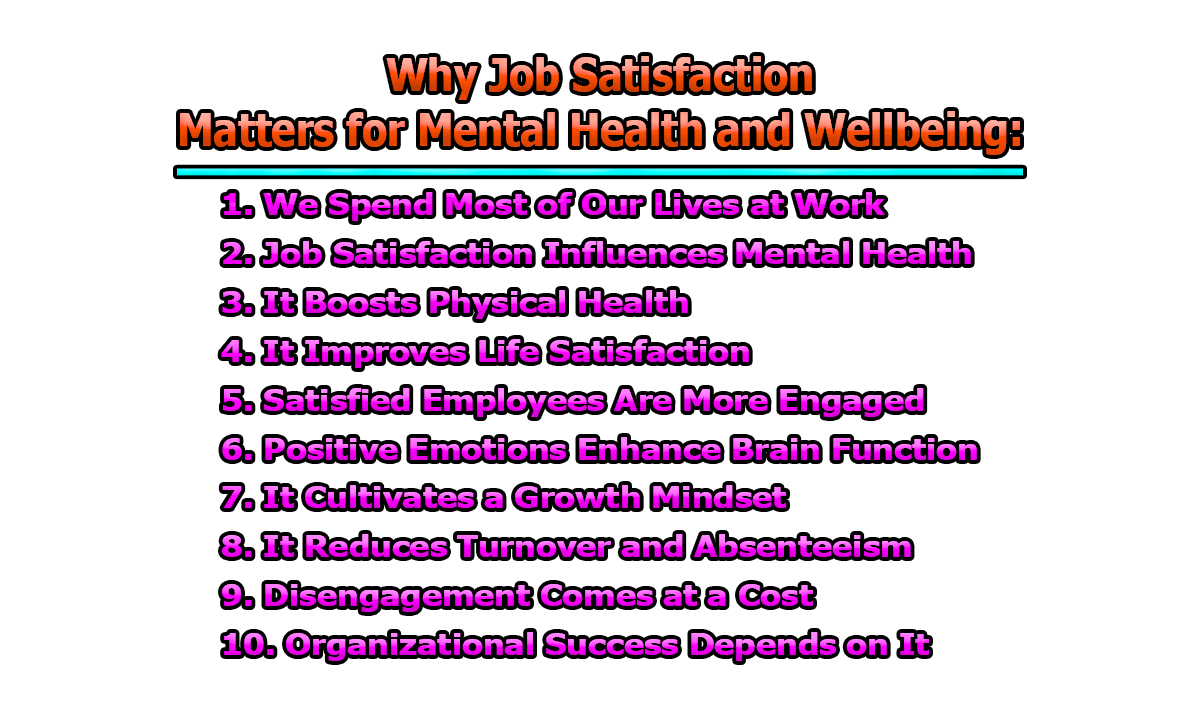Why Job Satisfaction Matters for Mental Health and Wellbeing:
Job satisfaction is more than just liking your job — it plays a vital role in shaping mental health, emotional wellbeing, and professional performance. A fulfilling work experience contributes to lower stress, greater motivation, and stronger connections with colleagues. Research shows that when people feel valued and supported at work, they are more likely to thrive both personally and professionally. Understanding the importance of job satisfaction helps create healthier workplaces and more resilient individuals. In the rest of this article, we will explore why job satisfaction matters for mental health and wellbeing.
1. We Spend Most of Our Lives at Work: The average person spends approximately 90,000 hours at work over their lifetime (Stoewen, 2016). That’s roughly one-third of a person’s total time alive. Given this immense time investment, the workplace becomes a major influence on mental health, emotional wellbeing, and life satisfaction.
Example: Imagine two employees in similar jobs. One works in a supportive environment where they feel respected and heard, while the other faces daily stress and a toxic team dynamic. Over time, the first person is likely to feel more energized and fulfilled, while the second may experience anxiety, low self-esteem, or even burnout. The contrast highlights how job satisfaction can shape one’s broader life experience.
2. Job Satisfaction Influences Mental Health: Job satisfaction plays a powerful role in reducing symptoms of depression and anxiety. When people feel valued and have clear goals, it leads to emotional stability and psychological security. Conversely, dissatisfaction at work can result in chronic stress, which is a known risk factor for mental health disorders (Nur Aqilah & Juliana, 2012).
Example: A healthcare worker who enjoys their role, receives recognition, and has work-life balance is more likely to remain mentally healthy — even in a demanding environment. On the other hand, someone in a similar position who faces constant criticism and lacks support may experience chronic anxiety or depressive symptoms, ultimately affecting their ability to care for patients.
3. It Boosts Physical Health: The connection between mind and body means that job satisfaction can have real physical effects. People who are unhappy in their jobs often report more physical ailments like headaches, fatigue, muscle pain, and even shortness of breath. These symptoms are often stress-related and can worsen over time if job dissatisfaction continues (Nur Aqilah & Juliana, 2012).
Example: Consider an office worker who dreads going to work each day. They may start developing back pain, trouble sleeping, or stomach issues. A colleague in the same role, but who feels challenged in a good way and appreciated by their manager, may have more energy and fewer physical complaints—even though they have the same workload. This difference is often rooted in how their job affects their emotional state and stress levels.
4. It Improves Life Satisfaction: Job satisfaction doesn’t just make work more enjoyable—it significantly enhances overall life satisfaction and psychological wellbeing. When people feel accomplished and fulfilled in their careers, that positive energy carries into their personal lives, relationships, and self-esteem (Matud & Sánchez-Tovar et al., 2024).
Example: A teacher who feels empowered by their administration, sees student growth, and receives appreciation is more likely to go home with a sense of purpose and contentment. This positivity often leads to better relationships with family and friends. In contrast, a teacher who feels ignored, overworked, or disrespected may carry frustration and fatigue into their personal life, impacting their mood and social interactions.
5. Satisfied Employees Are More Engaged: Job satisfaction is a key driver of employee engagement — how emotionally and mentally invested someone is in their work. Engaged employees are more productive, focused, and proactive. They contribute meaningfully, take initiative, and care about the company’s success (García-Buades et al., 2019).
Example: In a tech company, an engineer who is satisfied with their role might suggest creative improvements, help teammates, and volunteer for new projects. They feel ownership of their work. Meanwhile, a disengaged engineer — who feels underappreciated or lacks development opportunities — may stick only to basic tasks and show little interest in innovation. The first contributes to a thriving team culture, while the second simply “checks boxes.”
6. Positive Emotions Enhance Brain Function: When employees are satisfied, they tend to experience more positive emotions—like joy, hope, and interest—which in turn boost brain performance. This includes better problem-solving, creativity, and adaptability (Achor, 2010). Positive emotions also promote psychological safety, which supports learning and personal growth (Fredrickson, 2001; 2004).
Example: A graphic designer working in a supportive and inspiring environment may be more creative and come up with innovative visual solutions for clients. In contrast, one working in a tense, unsupportive office might struggle with focus and deliver average designs. Their emotional state—shaped by job satisfaction—directly impacts their cognitive performance and creative potential.
7. It Cultivates a Growth Mindset: When employees are satisfied in their jobs, they are more likely to develop a growth mindset—the belief that abilities and intelligence can be improved through effort and learning. This mindset thrives in environments where people feel emotionally safe and supported, which job satisfaction helps create (Fredrickson, 2001; 2004).
Example: A junior employee in a company that encourages feedback and recognizes effort will likely take on challenges, seek skill-building opportunities, and stay motivated during setbacks. Contrast that with someone who feels micromanaged and unappreciated—they may avoid risks or learning opportunities out of fear of failure or judgment. Satisfaction makes people feel safe enough to grow.
8. It Reduces Turnover and Absenteeism: Organizations with high job satisfaction enjoy lower employee turnover and absenteeism. When people like their work and feel valued, they are more loyal and committed. This reduces the time and money spent on hiring, onboarding, and managing constant staff changes (Gallup, 2024).
Example: A company that offers flexible hours, career advancement, and regular recognition may retain employees for years. On the other hand, a similar company that ignores employee needs may see constant resignations and sick leaves. This disrupts workflow and creates instability, even if salaries are similar.
9. Disengagement Comes at a Cost: According to Gallup (2024), 77% of the global workforce is disengaged—which leads to serious consequences like burnout, low morale, and underperformance. Disengaged employees are often mentally “checked out,” which not only affects their productivity but also the energy and motivation of their teams.
Example: In a retail store, disengaged workers may offer poor customer service, make more errors, and miss work more often. This affects customer satisfaction and sales. In contrast, engaged employees greet customers warmly, solve problems efficiently, and contribute to a positive atmosphere. The difference is rooted in how they feel about their jobs.
10. Organizational Success Depends on It: Employee satisfaction directly influences an organization’s success. Happy, engaged employees boost productivity, encourage collaboration, and drive innovation—key ingredients for long-term performance and competitive advantage (García-Buades et al., 2019; Pew Research Center, 2024).
Example: A startup that fosters job satisfaction through open communication, clear goals, and team support is more likely to grow steadily and retain talent. A similar startup that ignores team wellbeing might face frequent resignations, internal conflict, and stalled progress. The difference is not in funding or ideas—but in how satisfied and supported employees feel.
From the above discussion, we can say that in today’s demanding work culture, job satisfaction is not just a personal preference — it’s a strategic priority. It supports emotional balance, boosts performance, and reduces burnout, absenteeism, and turnover. Organizations that invest in employee satisfaction build stronger teams and achieve more sustainable success. Creating positive, meaningful work experiences benefits not only employees but the entire organization.
Frequently Asked Questions (FAQs):
What is job satisfaction?
Job satisfaction refers to how content and fulfilled a person feels with their job. It includes aspects such as work environment, job role, compensation, relationships with coworkers, and opportunities for growth.
How does job satisfaction affect mental health?
Job satisfaction significantly influences mental health. When people are happy at work, they tend to experience lower levels of stress, anxiety, and depression. A positive work experience supports emotional stability and psychological wellbeing.
Can job dissatisfaction cause physical health problems?
Yes. Chronic stress and dissatisfaction at work can lead to physical symptoms like fatigue, headaches, back pain, and even cardiovascular issues. Mental and physical health are closely connected.
Why is job satisfaction important for employers?
Satisfied employees are more productive, engaged, and loyal. They work more efficiently, take fewer sick days, and are less likely to leave, reducing turnover and boosting overall organizational success.
What factors contribute to job satisfaction?
Key factors include meaningful work, fair compensation, recognition, a supportive work culture, clear communication, work-life balance, and opportunities for growth and development.
Is job satisfaction the same as employee engagement?
Not exactly. Job satisfaction is how much someone enjoys their job, while engagement refers to how emotionally and mentally committed they are to their work. However, the two are closely related and often influence each other.
How can companies improve job satisfaction?
Companies can improve job satisfaction by offering recognition, encouraging feedback, providing professional development, promoting a healthy work environment, and respecting work-life boundaries.
What role do managers play in job satisfaction?
Managers have a major influence on job satisfaction. Supportive leadership, clear expectations, and regular feedback from managers can enhance employees’ sense of purpose, value, and motivation.
Can job satisfaction be measured?
Yes, organizations often use surveys and feedback tools to measure job satisfaction. These may assess areas like motivation, workload, communication, and relationships in the workplace.
Is it possible to be satisfied with a job that’s stressful?
Yes, if the stress is balanced with meaningful work, strong support, recognition, and personal growth. Challenging jobs can still be satisfying when employees feel valued and equipped to succeed.
References:
- Achor, S. (2010). The happiness advantage: The seven principles of positive psychology that fuel success and performance at work. Crown Currency.
- Fredrickson, B. (2001). The role of positive emotions in positive psychology: The broaden-and-build theory of positive emotions. American Psychologist, 56(3), 218–226. https://doi.org/10.1037/0003-066X.56.3.218
- Fredrickson, B. (2004). The broaden-and-build theory of positive emotions. Philosophical Transactions of the Royal Society of London. Series B, Biological Sciences, 359(1449), 1367–1378. https://doi.org/10.1098/RSTB.2004.1512
- (2024). State of the global workplace: 2024 report. Gallup. Retrieved April 3, 2025, from https://www.gallup.com/workplace/349484/state-of-the-global-workplace.aspx
- García-Buades, M., Peiró, J., Montañez-Juan, M., Kozusznik, M., & Ortiz-Bonnin, S. (2019). Happy-productive teams and work units: A systematic review of the ‘happy-productive worker thesis’. International Journal of Environmental Research and Public Health, 17(1). https://doi.org/10.3390/ijerph17010069
- Matud, M. P., Sánchez-Tovar, L., Hernández-Lorenzo, D. E., & Cobos-Sanchiz, D. (2024). Job satisfaction, mental symptoms, and well-being in adult workers: A gender analysis. Psychiatry International, 5(2), 253–267. https://doi.org/10.3390/psychiatryint5020018
- Nur Aqilah, M. Y., & Juliana, J. (2012). Association between occupational stress and respiratory symptoms among lecturers in Universiti Putra Malaysia. Global Journal of Health Science, 4(6), 160–169. https://doi.org/10.5539/gjhs.v4n6p160
- Pew Research Center. (2024, December 10). Job satisfaction: How U.S. workers feel about their jobs. Retrieved April 3, 2025, from https://www.pewresearch.org/social-trends/2024/12/10/job-satisfaction/
- Stoewen, D. L. (2016). Wellness at work: Building healthy workplaces. The Canadian Veterinary Journal = La Revue Veterinaire Canadienne, 57(11), 1188–1190.

Library Lecturer at Nurul Amin Degree College










